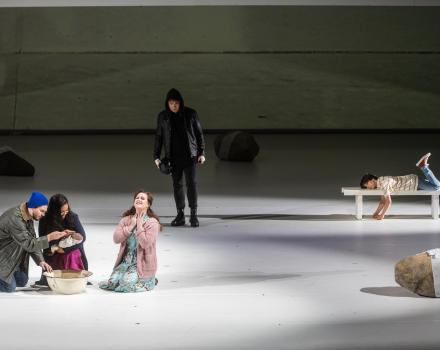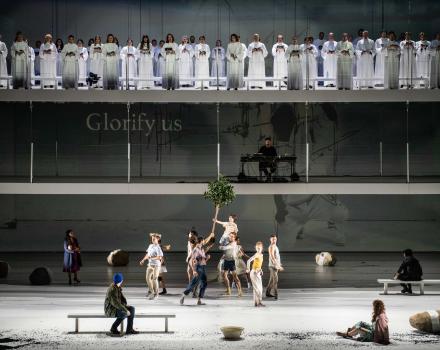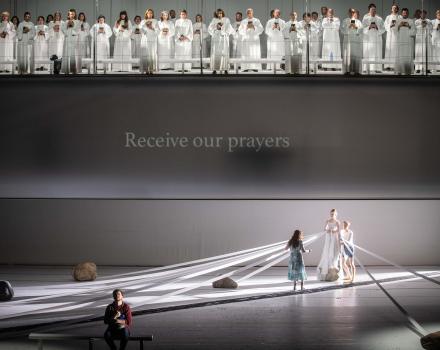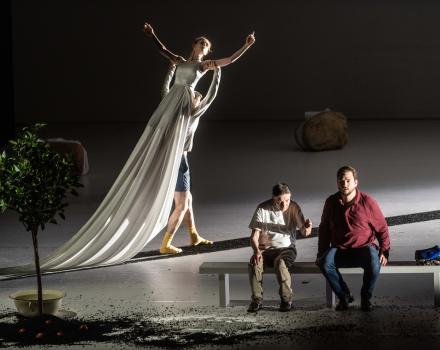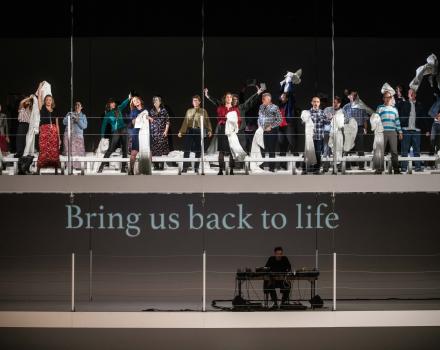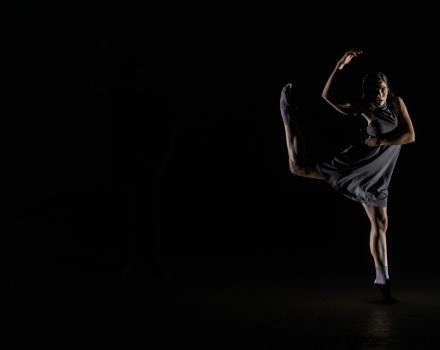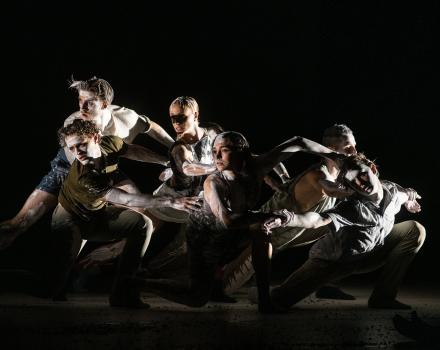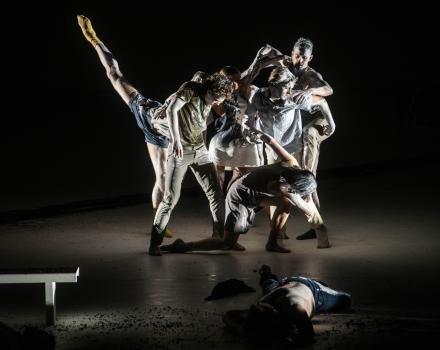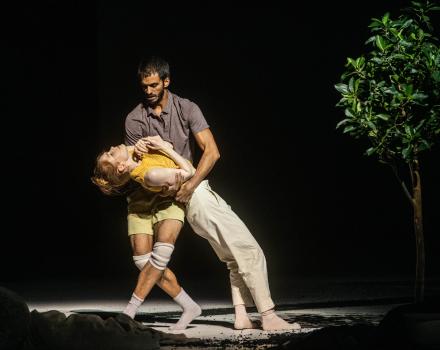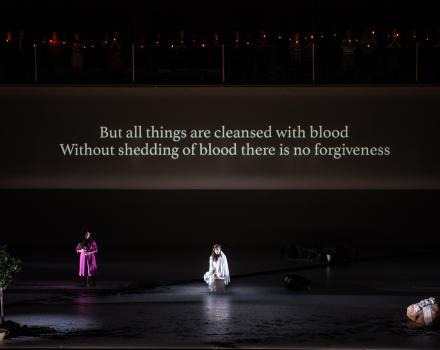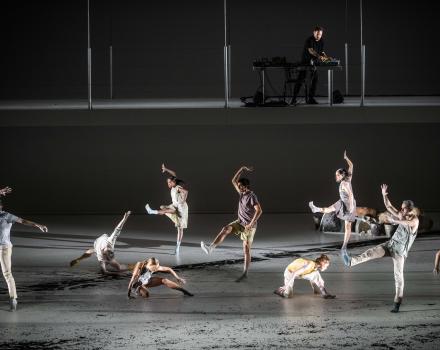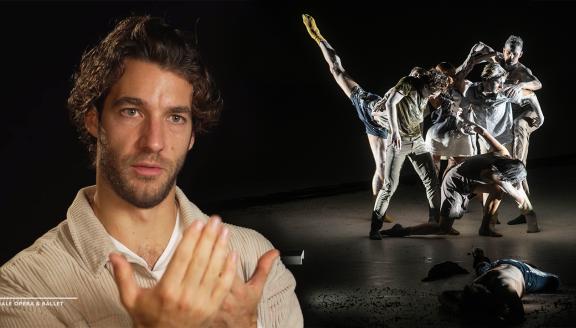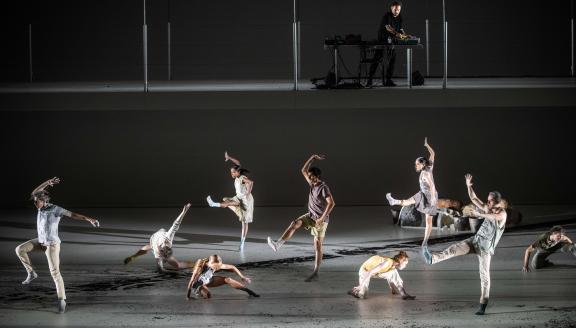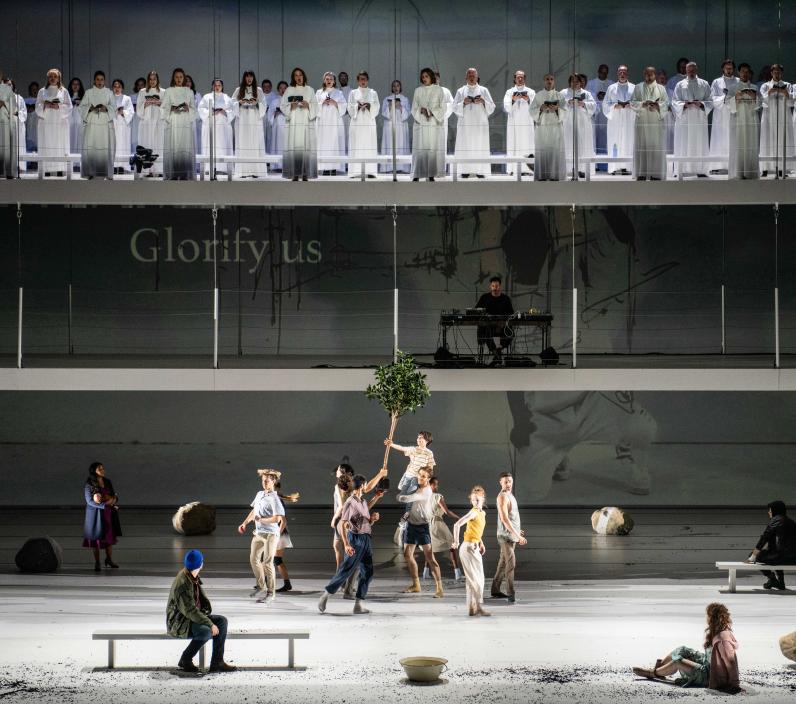

Haydn’s Missa in tempore belli is also known as the Paukenmesse (kettledrum mass) because of its dramatic use of timpani. Responding to the work's innate theatricality, Dutch National Opera presents the mass in a fully-staged performance. Director Barbora Horáková reveals the flipside of the unfaltering faith that runs throughout Haydn’s music, poignantly portraying individuals who suffer under the heavy burden of a narrow-minded ideology.
Swiss-Israeli electronic composer Janiv Oron responds to Haydn with beats and sound effects, all created live. These extra sound worlds offer a counterbalance to the religious conviction articulated by the Missa. The performance has a starring role for the Chorus of Dutch National Opera alongside four excellent soloists. The Spanish choreographer Juanjo Arqués, who is closely connected with Dutch National Ballet, has creating a choreography for nine dancers, giving physical expression to the dramatic tensions in this new mass for the 21st century.
Cast
|
Sopranos
|
Janai Brugger
|
|---|---|
|
Alto
|
Polly Leech
|
|
Tenor
|
Mingjie Lei
|
|
Bass
|
Johannes Kammler
|
|
Dancers
|
Dutch National Ballet
|
|
Chorus
|
Dutch National Opera Chorus
|
|
Orchestra
|
Netherlands Philharmonic Orchestra
|
| ... | |
|
Music
|
Joseph Haydn
|
|---|---|
|
Conductor
|
Lorenzo Viotti
|
|
Director
|
Barbora Horáková
|
|
Sets
|
Barbora Horáková
|
|
Lighting
|
Barbora Horáková
|
|
Costumes
|
Jorine van Beek
|
|
Chorus Master
|
Lionel Sow
|
|
Electronic music
|
Janiv Oron
|
|
Associate set designer
|
Sieger Kotterer
|
|
Associate lighting designer
|
Peter van der Sluis
|
| ... | |
Video
The story
As customary in the Latin Mass, Haydn's Missa in tempore belli has a number of fixed parts (ordinarium such as Kyrie, Gloria, etc), which in this production are interspersed with compositions by Janiv Oron (IN ITALICS).
BELLS
I. KYRIE
With the Greek words Kyrie/Christe eleison beg for mercy on behalf of the congregation.
RESONANT GARDEN
II. GLORIA
God the Father and Christ the Son are praised.
- Gloria in excelsis Deo ('Glory to God in the High')
BIKE FOR LOVE
- Qui tollis peccata mundi ('You who take away the sins of the world')
- Quoniam tu solus Sanctus ('For Thou alone is the Holy One')
FREQUENCY BAR
III. CREDO
The creed ('I believe in...') as laid down at the Councils of Nicea (323 A.D.) and Constantinople (381 A.D.).
- Credo in unum Deum ('I believe in one God')
- Et incarnatus est ('And he has taken on flesh')
BLOODHEART
- Et resurrexit ('And he has risen')
WASHED AND DRIED
IV. SANCTUS
Angels praise God on his throne. This is one of the oldest components of all liturgies, together with the following Benedictus.
V. BENEDICTUS
The homage of Jesus during his entry into Jerusalem ('Blessed he who comes in the name of the Lord').
PAUKEN
VI. AGNUS DEI
An ancient litany, in which the Lamb of God (Christ) is invoked for mercy and peace.
BELLS
Insights
Joseph Haydn composed many masses. He did so not only out of his own relgious devotion but above in response to commissions. This was true of his Missa in tempore belli, one of the six masses he wrote in the last phase of his life.
The mass does not tell a story with a plot and characters. The texts are those of the Latin mass: Kyrie, Gloria, Credo, Sanctus, Benedictus and Agnus Dei. They are addressed to God the Father and Christ the Son and culminate in the cry 'Dona nobis pacem' (Give us peace).
Director, Barbora Horáková and her team have created a piece of musical theatre based on this mass. They set themselves the challenge to enhance the dramatic tension and contrast of Haydn's work, which was never conceived as a performance presented without interruption. A celebration of mass would consist of other elements, such as a sermon, communion and readings from the Gospel. The artistic team have taken this idea to make their own additions, adding new music between the choral songs. These new parts are performed by composer and DJ, Janiv Oron, who makes music with self-built electronic instruments.
In the mass, four voices emerge as lyrical solos; soprano, mezzo, tenor and baritone become protagonists in the performance. Horáková found inspiration for these characters in intense, personal stories. A woman who has had an abortion following a rape. A boy who, struggling with his sexuality, seeks 'salvation' in sport. A man who as a child faced life-threatening illness without the support of his religious parents, themselves content to place his fate in the hands of God. A woman who leaves in a violent marriage with great difficulty, losing all support of those around her.
These individual experiences are set against the backdrop of a homogeneous group (the chorus), which towers above the whole. The performance is not only about personal traumas, but also about the afterlife and about how we can come closer to each other. The themes of forgiveness, faith and grace are universal and touch those with or without a faith in God. This is therefore a very human mass, a celebration of the creative power of mankind.
Gallery
